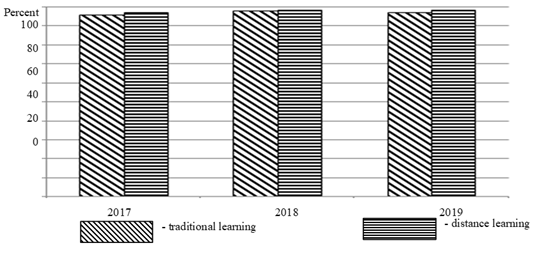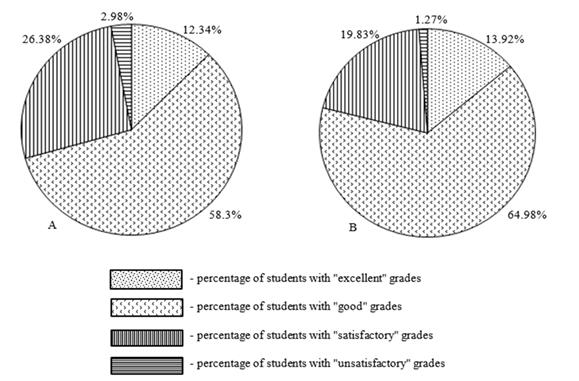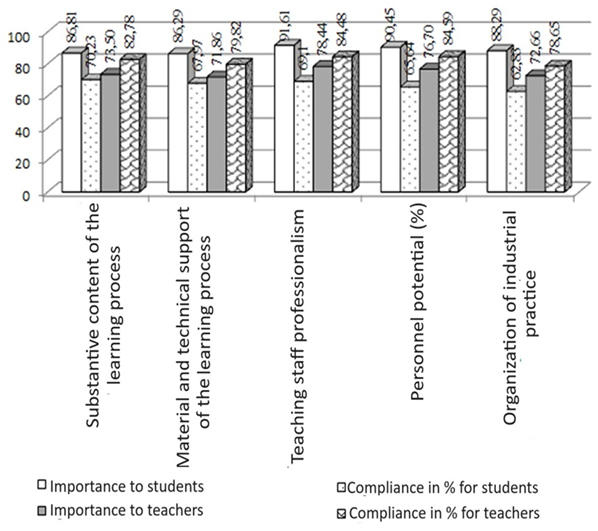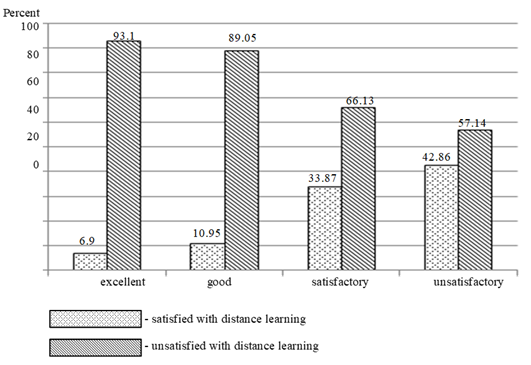Introduction
The fourth technological revolution predetermined the need for reform not only in the economic, social, and other spheres of social life in Russia but also in the education system. This is the cause of the transition to multilevel training in higher educational institutions, which is accompanied by the reformation of the Russian education system (transition from the knowledge-based model of education to the competence-based model, transformation of federal educational standards, widespread introduction of the credit-rating system, development of new methods and forms of implementation of the learning process, etc.). The idea of Science, Technology, Engineering, and Mathematics (STEM) education as a lifelong learning trajectory that provides continuous improvement of knowledge, skills, and abilities, integrating the learning process, career, and further professional development has received substantial development.
Recently, the transformation of the education system in the framework of STEM has occupied the minds of researchers in all developed countries. Scholarly works dealing with the problems of education (Davies, 2001; Geller et al., 2007; Bybee, 2013; Dedovets & Rodionov, 2015; Repin, 2017) disclose the basics of a systematic process of basic school and higher education based on the study of natural sciences in conjunction with mathematics, engineering, and other branches of science.
Great efforts for the development of STEM education are made in the USA, where about 47 thousand students are engaged in STEM education, and 30 states have officially adopted programs to support STEM. However, the Report to the President of Russia (2010), indicates that these institutions require much greater subsidies than traditional ones, which owes to specific technological and infrastructural characteristics. In the meantime, the level of education does not always meet the set bar.
Resolving the problems of raising the quality of education in the STEM trajectory gains acuteness as part of the deployment of distance education technologies, which is determined by the negative external shock experienced by Russia following the spread of the novel coronavirus infection. The quarantine regime of 2020 necessitated a full transition of Russian education to the distance mode of training.
Studies in the sphere of STEM education in general and the use of distance learning technologies in particular have been conducted by many Russian (Zotkin & Mukha, 2008; Bryksina & Tarakanova, 2016; Averin & Markova, 2017) and other researchers (Gordon & Gordon, 1990; Harvey & Goudvis, 2000; Algozzine et al., 2002; Denton & Mathes, 2003; Fantuzzo & Rohrebeck, 1992; Lunsfold, 2008). They point out that distance learning allows adapting the learning process to the specific needs of groups of students. Research papers also provide results and data proving the expediency of these forms of training based on a comparison of the academic performance of students in experimental and control groups.
In Russia, this type of research was conducted in 2019 by experts at the Higher School of Economics, who assessed the effect of utilizing the digital platform Yandex Textbook. The findings are uncertain: students with "satisfactory" grades improved their grades in mathematics, while "good" and "excellent" students remained at the same level. Knowledge of the Russian language was also unaffected by the use of the platform (Konyukhova, 2020). A considerable body of research is devoted to substantiating the choice of the instrumental environment for realizing the process of distance learning and its equipment with content and modern means of learning that provide for the development of professional skills and abilities in the distance format (Shilova, 2012).
We are highly inclined to believe that this ambiguity of findings owes to the fact that the large-scale introduction of distance learning tools in developing the STEM trajectory is rather haphazard. On the one hand, this is predetermined by the shortage of theoretical material systematizing the results of such experiments. On the other hand, the application of distance technology tools by different educational institutions demands fundamentally different methodological and technological approaches, which impose serious specific requirements on the knowledge and skills of teachers and students in each university.
Thus, today’s system of STEM education is marked by a conflict between the high demand for the introduction of distance learning technologies and the lack of methodological approaches to the systematization of distance learning tools as a unified information educational technology. The described contradiction determines the relevance of the present study.
Materials and methods
The methodological foundation of the study is formed by research works in the field of education (Gordon & Gordon, 1990; Harvey & Goudvis, 2000, Algozzine et al., 2002; Fantuzzo & Rohrebeck, 2004; Zotkin & Mukha, 2008; Averin & Markova, 2017; Schwab & Davis, 2022) and modern achievements in the use of active learning methods and innovative methods of educational process organization.
For further development of the mechanism to ensure the focus of the educational process on the development of sustainable professional competencies demanded by the labor market and created in line with consumer expectations and potential capabilities of the learner's personality, the concept of this study envisaged the use of classical research methods: analysis, synthesis, classifications, analogies, and empirical methods.
Empirical methods were utilized to assess:
The perceived importance of components in the educational process that shape education quality and the level and sustainability of competencies developed by graduates for teachers and students. The respondents included students in their final years of studies and university faculty. The research method is a questionnaire survey conducted during the period of industrial practice. The student sample size amounted to 47% of students from the total number of students in the last year of study;
The adopted research methodology ensured the validity of conclusions on the adequacy of the university response to consumer expectations and the representativeness of the results, which was confirmed by the outcomes of practical implementation of the formulated theoretical conclusions.
The practical significance of the research findings consists in the creation of a conceptual model that reflects the structure, content, quality requirements, and tools of distance learning technologies, with due consideration of the varying quality of the resources available in the environment and ultimately ensures the effective implementation of the STEM trajectory in higher educational institutions.
Results and discussion
The STEM system markedly differs from the traditional education system. It presents a mixed learning environment that assumes an adjustment of the traditional system using the interdisciplinary and application-oriented approach, as well as distance learning tools. At present, the prerequisites for the implementation of the STEM system are widely realized, including students' ability to choose an individual educational trajectory based on the model of continuous professional education, active use of network interaction between all subjects in the educational process, increased student mobility, and active realization of the export potential of education, etc.
Analyzing our experience in using distance learning tools as part of attempting to build a STEM trajectory in real-world activities, we identified the following problems:
Their chaotic use without due consideration of the specific features and conditions of a particular situation not only significantly reduces their effectiveness (Kiselitsa, 2019), but also has virtually no effect on the absolute performance of students.
Analysis of qualitative academic performance reveals a different dynamic: an average growth of 8-9% in the transition to distance forms of education, and by 10-15% for some groups (Figure 1).
 Source: Preparation of authors
Source: Preparation of authorsFig. 1 - Absolute student performance in traditional and distance learning.
Absolute academic performance in the traditional form of training ranges from 96.08 to 98.01%. With distance learning it is not significantly higher (by 0.49-1.68%) and ranges between 97.04 and 98.7% (Figure 2).
 Source: Preparation of authors
Source: Preparation of authorsFig. 2 - Average results of primary final certification in traditional (a) and distance (b) forms of training.
The outlined trend is shaped by the fact that the preliminary final examination shows a decrease in the share of unsatisfactory grades by two times and in the percentage of "satisfactory" grades by 6.55% (up to 10-12% in some groups), coupled with an increase in "good" grades by 6.68% (15-20% in some groups) and "excellent" grades by 1.58%.
These results are primarily due to many teachers’ lack of experience working with information technology, as well as the low information literacy of most students. According to a survey of student groups that have significantly improved their performance, in first place by significance in improving grades comes the assistance of peers who know the subject well (60.29%), in second place is the use of devices allowing access to the Internet and lecture materials (55.39%), and in third place is getting access to test answers (18.63%).
2. A low level of adaptation of educational process components to consumer expectations. Differing perceptions of educational process quality by the party providing educational services, the party receiving them, and the party interested in the quality of education (employers). Different levels of satisfaction with "expectations"-"execution". The quality of educational services provided by the university was evaluated by complex indicators reported in Figure 3.
 Source: Shilova (2012).Fuente: Elaboración propia
Source: Shilova (2012).Fuente: Elaboración propiaFig. 3 - Average results of primary final certification in traditional (a) and distance (b) forms of training.
The complex indicators were formed based on the results of evaluating individual indicators:
Organization of industrial practice: duration, terms (time interval in the academic year), the bases for industrial practice, management of the practice on the part of the object of practice and graduate departments, requirements to the report, and defense procedure;
Substantive content of the learning process, the components assessed included: the range of forms of training, the list of disciplines within the educational program, the structure of the curriculum in terms of credits and forms of classes, the content of lectures and practical classes, the level of application of active learning methods, additional classes in disciplines, forms of knowledge control, etc.
The survey of teachers and students shows the following:
Students expect more interesting content in the curriculum and a higher level of technical equipment, about 20% of students are not satisfied with the organization of industrial practice. In all these components, the indicators of teachers' evaluations are above their expectations. This dissonance, unfortunately, indicates a somewhat inaccurate perception of consumer expectations by university faculty.
The higher educational institution has problems with teachers' perception of the quality of their labor and its significance for the development of necessary competencies. The main problems are that teachers rate the quality of their teaching highly (a quarter higher than students), belittle their significance and the significance of all components of the educational service evaluated in the study, and shift most of the responsibility for the quality of education to students.
The striving to mass use of distance technology tools in STEM education in all forms of training (classroom training, solving cases and tasks, defense of term papers and graduate theses, etc.) often has negative consequences leading to the disappointment of teachers and students and their reluctance to use these instruments in practice (Figure 4).
 Source: Preparation of authors
Source: Preparation of authorsFig. 4 - The attitude of students to distance learning depending on academic performance.
In the progression from the category of students graded "unsatisfactory" to the category of "excellent", satisfaction with the use of distance education decreases from 42.86 to 6.9%. This is explained by the established moral principles and requirements for the realization of the principle of fairness in assessment. Yet even students with "unsatisfactory" and "satisfactory" grades, having a chance to get undeservedly higher grades, show a rather high dissatisfaction with this system - from 33.87 to 42.86%. This is also connected with the requirement of the principle of fairness, as well as with the fact that 94.2% of students note a decrease in the quality of their knowledge with the transition to distance forms of education.
It seems important and topical to solve the problem of creating an effective STEM trajectory. However, in the conditions of modern post-industrial society, it is impossible to solve this task without using a set of distance tools. In our opinion, two issues have come to the fore. The first is the creation of conditions and incentives to increase students' motivation, which will facilitate independent innovative behavior among most of both teachers and students. The second is the ratio of distance and traditional classes in the overall structure of the educational process, providing the establishment of said conditions and incentives.
In our view, it is advisable to form a universalized STEM trajectory, which would allow working with individual educational programs of different levels and with students at different levels of training, while providing for the development of their ability to independent training. Such a trajectory, we believe, should be realized in all models of education (Table 1).
Table 1 - Main characteristics of STEM trajectory using remote technologies.
| Characteristic | Bachelor's (Specialist's) degree, year 1-2 | Bachelor’s degree, year 3-4 (Specialist’s degree, year 3-5) | Master’s degree | Graduate school |
|---|---|---|---|---|
| Share of distance learning in classroom sessions, % | 0-5 | 5-10 | 10-15 | 50 |
| Share of distance learning in extracurricular activities, % | 5-10 | 10-15 | 15-20 | 50 |
| Results | Basic projected | Basic planned | Methods of completed projects | Presentation of research in the global community |
| Creative component | Development of skills | Development of creativity | Development of the research component | Production of scientific ideas |
| Motivational component | Development of the basic level | Deepening | Secondary deepening | Fully developed |
Source: Preparation of authors
We argue that the creation of the STEM trajectory with the use of distance technologies has to include four stages as applied to three levels of training in higher education (Bachelor’s (Specialist’s) degree, Master’s degree, and postgraduate school):
Bachelor's (Specialist's) degree - year 1-2 - the main attention should concentrate on building students' motivational component, as well as on achieving basic projected results. This can be achieved, first of all, through the implementation of a personality-oriented approach, particularly using educational technology to achieve projected results. This technology assumes activization of the process of students' developing subjective experience, on the one hand, and elements of self-development, on the other hand. The projected result in this case suggests the achievement of specific goals and results regarding competencies to be developed at this stage. This technology implies the trajectory of educational progress from the formation of the general information space of the subject, i.e., the elements of the future system of projected results, to the confirmation of the fact of achieving the projected results. The share of distance forms in classroom training should not exceed 5% and in extracurricular training - 10%.
Bachelor’s (Specialist’s) degree - year 3-4(-5) - the achieved basic projected results allow moving to the next level - deepening motivation in the learning process and developing primary researcher skills, elements of independent research, the creative component, etc. It is imperative to achieve the planned results. As an example, we can recommend the technology of differentiated and individualized learning with planned results as a means of implementing a personality-oriented approach. Along with other similar tools, it allows one to realize the principle of fairness so valued by students and to rule out equalization and averaging of the final and intermediate results. This technology has proven itself among both stronger and weaker students. The stronger ones take advantage of opportunities to master topics quicker and in greater depth, as per their individual needs and desires. Weaker students, in turn, develop independence in solving specifically assigned tasks that do not require in-depth research. As a result, their motivation increases as they are satisfied and pleased with the results. The planned learning outcome for them is to master the skills of solving the minimum number of tasks necessary for a threshold level of knowledge and satisfactory final certification. The share of distance forms in classroom training should not exceed 10%, in extracurricular training - 15%.
Master’s degree is the second stage of university education, which implies the advancement of professional knowledge. This is enabled by stimulating the research component of undergraduate studies. Access to world resources online with the use of the method of completed projects, which together provide a secondary deepening of motivation, act as the providing tool. As an example, we shall consider the Bring your own devices (BYOD) method, which assumes the use of the devices students already have. This method can effectively stimulate the actualization of students' passive knowledge, which in turn has a favorable effect on secondary interest in learning. The share of distance forms in classroom training should not exceed 15%, in extracurricular training - 20%.
Graduate school - is the third and final stage of higher education. This path is taken by a smaller number of students, so it is not a mass one. Scientific supervisors and teachers should complete the process of developing the ability of graduate students to critically assess the current level of accumulated knowledge in the specific professional field when solving various problems, including in interdisciplinary areas of research. The formation of such competencies requires the graduate student to carry out serious independent research work with the mandatory presentation of the obtained findings in the global space. In this respect, it appears expedient to consider the flipped classroom method, which involves students studying most of the theoretical base independently. The teacher’s presence is required only when covering challenging topics and creative and research tasks. This method allows one to fully realize the research component of graduate studies, as well as to use classroom hours, when teacher-graduate student interaction takes place, with high productivity. In this case, the share of distance forms should not exceed 15% in classroom training and 20% in extracurricular training.
Thus, moderated use of distance learning technologies at the initial stage of realizing the STEM trajectory will provide the opportunity to get quality education at any level in accordance with each student’s abilities. As skills in distance technologies grow and their full support with technical capacities becomes available, their role in the learning process will increase. Distance learning technologies will enable the implementation of the STEM trajectory of training for various population groups and people who lack the necessary time, financial, and other opportunities to obtain STEM education.
Recently, scientific communities have been seeing plenty of projects and initiatives in the sphere of developing STEM training trajectories, including with the use of distance technologies (Yasady et al., 2000; Berkeley, 2010; Kiselitsa, 2019). Notwithstanding, global research into the efficiency of online platforms and other instruments of distance learning produces rather contradictory results.
For instance, studies conducted in Chile demonstrate that digital services improve students’ leadership and communicative abilities yet fail to develop knowledge of the subject. Researchers in the USA are divided: some confirm the benefits of these services for the development of literacy in mathematics and natural sciences, while others refute their utility altogether. Some experts prove that distance learning tools develop problem-solving abilities in children, but the cost of their mass introduction is too high. Chinese researchers have discovered the usefulness of digital services in studying the English language, under the condition that they are integrated into the curriculum. Furthermore, they note the effect of students’ gender on the efficiency of these instruments, with male students benefiting more than females (Algozzine et al., 2002).
The STEM trajectory is also noted to be high in cost - up to 10 million USD for each high school and 2 million for secondary and elementary schools (President of Russia, 2010).
Therefore, for now, the world does not have clear technologies to consolidate various instruments of distant interaction into a single technology and a unified environment that would provide for the successful implementation of the STEM trajectory.
The model proposed in this study allows building such a model at the initial stage, reflecting the structure, content, requirements to quality, and distance technology tools given the varying quality of resources available in the environment. Ultimately, the described model will provide an effective realization of the STEM trajectory at universities.
Conclusions
The obtained findings allow us to outline directions for further research.
First, with optimal combination and efficient organization of the educational process, distance technologies with their wide range of benefits will take the leading position in the market for educational services, including in the STEM sector. This raises the need to intensify research in the field of theoretical and methodological support for the development of distance learning in the educational environment.
Second, distance technologies, being innovative at their core, may serve as quite an effective tool to support forward-looking vocational training. In this respect, they stimulate an increasingly fast and complete realization of the creative and intellectual potential of individual municipalities, regions, and the entire world community, raising their competitiveness in the global community.
Third, one-sided efforts of participants in the educational process, e.g. the university, its undergraduate, master’s, and postgraduate students, the state, and other partners of the university cannot ensure a high impact from the realization of STEM technologies. The conditions of today’s post-industrial society require synergistic effects from their interaction. Therefore, we believe it to be highly important and timely to create a technology of STEM education that would facilitate the integration of distance and traditional educational technologies rather than leave them opposed to one another.














